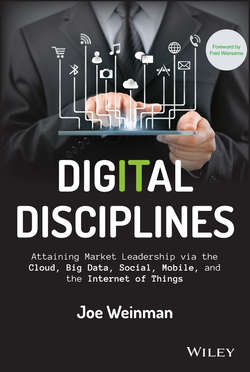Читать книгу Digital Disciplines - Wiersema Fred - Страница 9
На сайте Литреса книга снята с продажи.
Part One
Overview and Background
Chapter 1
Digital Disciplines, Strategic Supremacy
Information Excellence
ОглавлениеAlthough implementation details of the four digital disciplines of necessity vary in their application across industry verticals and by firm, as generic competitive strategies, they are easy to understand.
Information excellence is not shorthand for data quality, but the employment of comprehensive real-time information, predictive analytics, dynamic optimization, and integrated virtual and physical operations to implement better business processes and to better use assets.
“Better” as perceived by customers in terms of quality and performance. “Better” in terms of financial metrics, such as returns on invested capital through better asset utilization. “Better” in seamlessly integrating the virtual and physical worlds of information and operations. “Better” in terms of activities, process design, and rightsizing assets – doing things right – and outcomes – doing the right things. “Better” as in faster, cheaper, more flexible, higher quality, more reliable, more convenient, easier to use, more available, or more sustainable. “Better” as in making better decisions; executing those decisions with higher likelihood of success; and doing it all faster than the competition. Business processes are not limited to internal back-office constructs, but extend to customers, customers' customers, and end-users, as well as to supply chain partners and other stakeholders.
Businesses can exploit information throughout virtually all processes. Which customers should be targeted with promotions? Which services are most profitable and should receive incremental marketing investments? Which direct mail layout results in the greatest response rate? Which products will sell the most this season and thus should be inventoried to minimize stock-outs? Those are obvious kinds of questions that big data and predictive analytics can help answer. But it isn't just sales, marketing, or supply chain optimization. How about whose air conditioner should be lowered or shut off to avoid brown-outs? Which of the candidates is best for this job? How fast should this train go? Which potholes should be fixed first? Is this melanoma? The essence of information excellence is acquiring data, analyzing it, synthesizing information and insight, and then making decisions and optimizing virtual and physical processes, customer experiences, and relationships.
For example, UPS plans its routes via ORION (On-Road Integrated Optimization and Navigation), which implements state-of-the-art algorithms to minimize driving distance and fuel consumption while minimizing late deliveries.7 If an average truck needs to make 120 stops, there are 6,689,502,913,449,135,000,000,000,000,000,000,000,000,000,000,000,000,000,000,000,000,000,000,000,000,000,000,000,000,000,000,000,000,000,000,000,000,000,000,000,000,000,000,000,000,000,000,000,000,000,000,000,000,000,000,000,000,000,000,000,000,000,000,000,000,000 different possible sequences of stops, not including additional options to get from one stop to the next.8 UPS has 55,000 such routes in the United States alone, and therefore 55,000 such calculations to perform. Every day. This type of problem is obviously not amenable to human solution, and to make things even more complex, ORION needs to balance out an optimal solution with a degree of delivery consistency. UPS expects to save several hundred million dollars annually when ORION is fully deployed.
Kroger's QueVision system uses infrared cameras to track shopper arrivals, feeding a proprietary algorithm that then predicts the number of cashiers needed, reducing average wait time eightfold. And Kroger isn't just focusing on its own processes; it's also aiding consumers with theirs: a mobile app will plot out optimal paths through the store based on grocery lists.9
Chapter 7 will delve into Burberry, which has leveraged information excellence to achieve dramatic growth in the luxury goods industry, by offering streamed fashion shows live at stores on the world's biggest digital signage, deploying mirrors in dressing rooms that magically display runway clips of the clothing items being tried on, and by arming store personnel with a customer's purchase history on an opt-in basis to ensure fashion consistency.
7
David Zax, “Brown Down: UPS Drivers vs. the UPS Algorithm,” FastCompany.com, January 3, 2013, www.fastcompany.com/3004319/brown-down-ups-drivers-vs-ups-algorithm.
8
Steven Rosenbush and Laura Stevens, “At UPS, the Algorithm Is the Driver,” Wall Street Journal, February 16, 2015, www.wsj.com/articles/at-ups-the-algorithm-is-the-driver-1424136536.
9
Kim S. Nash, “State of the CIO 2014: The Great Schism,” CIO.com, January 1, 2014, www.cio.com/article/744601/State_of_the_CIO_2014_The_Great_Schism.
